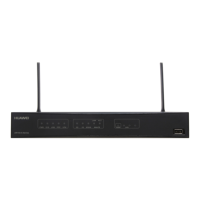Procedure
Step 1 Configure IP addresses and routes between Router A and Loghost. (The detailed procedure is
not mentioned here.)
Step 2 Enable the information center.
# Enable the information center.
<Huawei> system-view
[Huawei] info-center enable
Step 3 Add the ID of a log to be filtered.
# Configure the module and channel used to output alarm messages.
[Huawei] info-center filter-id 1077514264
Step 4 Configure binary logs to be sent to the log host.
[Huawei] info-center loghost 10.1.1.6 binary
Step 5 Verify the configuration.
# Check the added ID of the log to be filtered.
[Huawei] display info-center filter-id 1077514264
ID: 1077514264
Content: task: [string] ip: [string] user: [string] command: [string]
Filtered Number: 3
# Check the channel used by the SNMP agent to output alarms.
[Huawei] display info-center
[Huawei] display info-center
Information Center: enabled
Log host:
10.1.1.6, channel number: 2, channel name: loghost
language: english, host facility: local7
binary loghost, port number: 514
Console:
channel number: 0, channel name: console
Monitor:
channel number: 1, channel name: monitor
SNMP Agent:
channel number: 5, channel name: snmpagent
Log buffer:
enabled
max buffer size: 1024, current buffer size: 512
current messages: 499, channel number: 4, channel name: logbuffer
dropped messages: 0, overwritten messages: 0
Trap buffer:
enabled
max buffer size: 1024, current buffer size: 256
current messages: 9, channel number: 3, channel name: trapbuffer
dropped messages: 0, overwritten messages: 0
Logfile:
channel number: 9, channel name: channel9, language: English
Information timestamp setting:
log - date, trap - date, debug - date
Sent messages = 15274, Received messages = 15274
----End
Configuration Files
#
Huawei AR150&200 Series Enterprise Routers
Configuration Guide - Device Management 2 Information Center Configuration
Issue 02 (2012-03-30) Huawei Proprietary and Confidential
Copyright © Huawei Technologies Co., Ltd.
42

